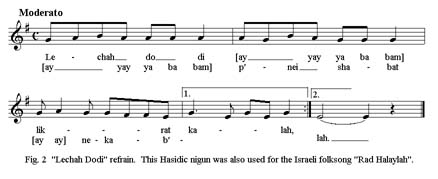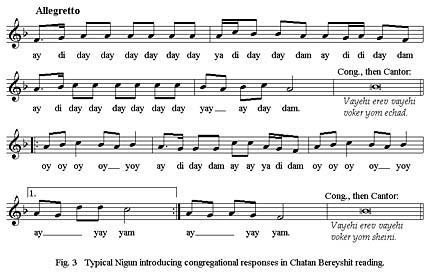Congregational Singing in Hasidic Congregations
by Cantor Sam Weiss
This article first appeared in Volume XXX of The Journal of Synagogue Music, published by The Cantors Assembly.
Considering the extent to which song pervades the lives of Hasidim, one would think that congregational singing is commonplace in their worship services. And this is indeed the case—but only if one defines "congregational singing" so broadly as to comprise all manner of resounding, spirited, and nusach-filled liturgical chanting emanating from the pews. Defined conventionally, however, as a group singing a uniform prayer-text in unison, congregational singing is rarely heard in the typical Hasidic minyan—whether in a small shtibl or in a large synagogue. While the musical culture of Hasidism has shaped congregational singing in synagogues all over the globe, Hasidim themselves rarely sing the equivalent of a "Vetaheir Libeinu" or a "Yismechu" in the course of a Sabbath service.
This paradox is not as strange as it might seem at first blush. A primary function of unison synagogue song is to promote active involvement on the part of an otherwise passive congregation. Since the Hasid typically engages the act of divine worship in high gear, fully focused on the meaning of the prayers and carried along by the force of their nusach, this function is largely unnecessary. Congregational singing, in such a context, could even become counter-productive, impeding the natural flow of davening. Consequently, texts like Vetaheir Libeinu or Yismechu might figure prominently among the hundreds of para-liturgical songs in the Hasid's musical repertoire, but they are not accorded any special treatment in the service proper.
Another function of congregational singing is to accentuate a particular text and highlight it within the surrounding nusach chant through the novelty of rhythm, tempo change, or other ingratiating musical characteristics. The effect of such musical stimulation, however, is not as striking for Hasidic congregants, who live and breathe music every day of the year in a variety of sacred and secular contexts. Indeed, there is ample opportunity for communal religious song on a Sabbath or Festival, but only outside the prayer service per se—inasmuch as "congregational" singing in unison or close harmony characterizes the zemirot and nigunim sung at home meals, at seudah shelishit, and at the Rebbe's Friday night or melaveh malkah table. True, musical inspiration also abounds at Shacharit, Mincha and Ma'ariv; in a typical Hasidic minyan, nevertheless, it is the fervor of fulfilling the Mitzvah of prayer that drives the musical inspiration, and not vice versa.
Having twice made mention of the "typical Hasidic minyan," we should hasten to add that there really is no such thing. Hasidic congregations are probably the most heterogeneous among Ashkenazic denominational groups. Despite their unvarying black garb, Hasidim have a multiplicity of customs and prayer styles that each sect treasures as hallmarks of its identity. We will note some of these variations even as we delineate the characteristics common to most Hasidic congregational singing.
Perhaps the most important feature that distinguishes general Hasidic singing from the singing that takes place during a prayer service is that the latter is almost always without actual words. That is, whenever a ba'al-tefillah1 sets a particular prayer or piyyut to a congregational melody, he alone sings the text; the other worshipers experience the words vicariously, by supporting his melody with vocables or hummed tones. This kind of "congregational accompaniment" typically drowns out the voice of the ba'al-tefillah, with the result that his lone singing of the prayer-text functions as a kind of "semantic accompaniment" to the lusty wordless singing of the congregation. Alternatively, one might conceive of the ba'al-tefillah's role in this context as that of a conductor who cues the entrance of his chorus by singing the first few notes of their part. The chorus here is the entire congregation, which performs the song "instrumentally." The words—in plain sight on the page of the Siddur, and usually even memorized—inspire the singing, but they remain unsung.
On a theoretical level, these congregational "songs without words" are in line with the fundamental Hasidic approach to singing, in which the melody of a nigun is at least as important as the words that carry it. On a more practical level, however, this approach to congregational singing is dictated by the halachic proscriptions against hafsakah, or interruption of the statutory prayer texts by unnecessary repetition of the words. Thus a cantor's extended melodic fantasia on the passage in the Shacharit Kedushah Mimkomcha Malkeinu, supported by congregational obbligati on yam-bam and ay-day (a favorite among Hungarian and Galician Hasidim), is perceived as a valuable and desirable intensification of kavvanah, while a single word in that passage sung by a congregant would constitute an unwelcome intrusion into the prayer ritual (see Figure 1—click on image to enlarge).
The kind of wordless congregational singing described above is heard most typically in the Friday night prayer Lechah Dodi, and in its Saturday morning counterpart Eil Adon. These two piyyutim are performed in the following pizmon format: The cantor starts to sing. In a matter of seconds the alert congregation "names that tune" and joins in the nigun. As he reaches the end of the first verse, the cantor pauses. The congregation then recites aloud the first verse, plus the second verse. The cantor continues from where he had paused, and sings the second verse, again accompanied wordlessly by the congregation. At the end of the second verse he pauses for the congregation to recite the third verse, and this pattern continues for the rest of the prayer; i.e. he sings the verse which the congregation has just recited.
Hasidic performance style of piyyutim (and of many zemirot as well) normally does not distinguish between "verses" and "refrains." Thus the opening line "Lechah dodi likrat kallah, penei shabbat nekab'lah," sung twice, functions musically as one verse, and each subsequent singing or recitation of that recurring line (what we normally would call a refrain) is simply absorbed into the preceding verse. In most melodic settings, this requires the cantor to "pad" that single line with filler vocables so that the metrical symmetry of the tune remains intact (see Figure 2—click on image to enlarge).
Not all sects follow this musical convention for these two piyyutim. Many Ukrainian and Lithuanian Hasidic dynasties (Ruzhiner, Boyaner, Slonimer, etc.) do not sing them at all, but instead recite the verses of Lechah Dodi and Eil Adon responsively with the ba'al-tefillah. The Karlin-Stoliner don't even go that far, treating Lechah Dodi like a regular prayer: The cantor recites only the first and last verses in the prevailing Kabbalat Shabbat nusach. In the last few decades some of these dynasties (e.g. Skverer and Lubavitcher) have adapted their services to the prevalent Minhag of singing these piyyutim, even though their historical Minhag was not to sing them. In the Bratslaver shtiblekh we find a variation on the Lechah Dodi theme that is a bravura display of musical imagination and kavvanah: cantor and congregation recite one verse at a time, then both cantor and congregation sing a nigun to this verse, with nobody singing the words.
Practically all Hasidic congregations that sing Lechah Dodi divide the verses into two musical sections, switching melodies at Lo Teivoshi. The melodies that are used for the first five verses (or six, counting the opening couplet) tend to be more sedate than the ones used for the last four verses. In addition, the second melody is usually also in a new meter, so the change in mood is rather striking. Several homiletical explanations have been advanced to account for this custom of shifting melodies, but the most plausible explanation seems to be simply the desire for musical variety. Details of this practice are not uniform over the entire Hasidic landscape: The Bratslaver and the Vizhnitzer, for example, switch to the new tune at the seventh verse rather than the sixth, while Polish and Galician Hasidim (Gerer, Bobover, Modzitzer, etc.) tend to choose lively melodies for both sections.
The six verses of the Shabbat morning hymn Eil Adon are always sung to a single melody in the pizmon format described earlier. The exceptional Hasidic groups, who do not sing piyyutim at all, recite these verses responsively. Virtually all Hasidic congregations also recite responsively the nine2 sentences of Hakol Yoducha, the piyyut that immediately precedes Eil Adon. None of the other commonly sung Shabbat prayers—including the fixed-meter piyyutim such as Adon Olam and Yigdal—is generally accorded any special melodic treatment in Hasidic congregations.
Congregational singing plays a greater role, however, on Festivals (Hallel, Yah Eili, Tal, Geshem, etc.) and the High Holidays (Zochreinu Lechayim, Mechalkeil Chayim, Areshet Sefateinu, Ein Kitzvah, Heyeih Im Pifiyot, Ha-yom T'amtzeinu, Ki Hinei Kachomer, etc.). Newly composed nigunim often get their inaugural hearings at these special prayers. Veye'etayu Kol L'ovdecha, for example, is a favorite High Holiday piyyut for presenting premieres of extended Hasidic marches. Most of these holiday prayers and piyyutim, moreover, are characterized by much more congregational singing of the actual words, owing to their contexts in the cantor's repetition of the Amidah or in other points of the service where the restrictions of hafsakah do not apply.
The preeminent occasion for Hasidic congregational singing is without a doubt the Festival of Simchat Torah. Not only is there singing during the prolonged hakafot, and dancing to all manner of nigunim with and without texts, but responsive chanting abounds in Atah Hor'eita, Sisu Vesimchu, and the piyyutim that are inserted into the hakafot (e.g. Ha-aderet Veha-emunah, Mi-pi Eil). An interesting custom in the Torah Reading from the beginning of Genesis on Simchat Torah morning (Chatan Bereishit) is the singing of a joyous nigun as a prelude to each of the six congregational responses of "Vayehi erev vayehi voker yom…"(see Figure 3—click on image to enlarge).
Hasidic congregational dancing is not confined to Simchat Torah. The Bratslaver Hasidim, for example, conclude every Kabbalat Shabbat service with a suite of traditional dances. Some Bratslaver congregations perform the dances between Kabbalat Shabbat and Ma'ariv, while others wait until the end of services. The Karliner have a traditional nigun and dance that is performed every day, exclusively during the seven weeks of Sefirat Ha-omer.
As suggested at the beginning of this survey, a proper appreciation of the congregation's participation in Hasidic worship requires a more comprehensive understanding of the term "congregational singing." Needless to say, all of the statutory responses in prayers like Bar'chu, Kaddish, Kedushah, etc. are taken up by Hasidic worshipers with all the gusto they can muster. Similarly, the entire annual cycle of Mi-sinai melodies are familiar to Hasidic congregants young and old, who chant them along with the ba'al-tefillah. In our examination of the various practices regarding Lechah Dodi, we contrasted congregations that sing the verses to those who recite them responsively. Yet since such "responsive reciting" is actually "responsive chanting aloud in the prevailing nusach," this choreographed swell of voices falls squarely under the functional heading of "congregational singing" no less than any Sulzerian cantor-congregation call-and-response does. Viewed in this light, Hasidic congregations are indeed paragons of congregational singing.
1 The terms ba'al-tefillah and cantor are used interchangeably in this article to denote the lay prayer-leader in Hasidic congregations. [return to article]
2 Nusach Ashkenaz has only eight sentences in Hakol Yoducha. [return to article]




